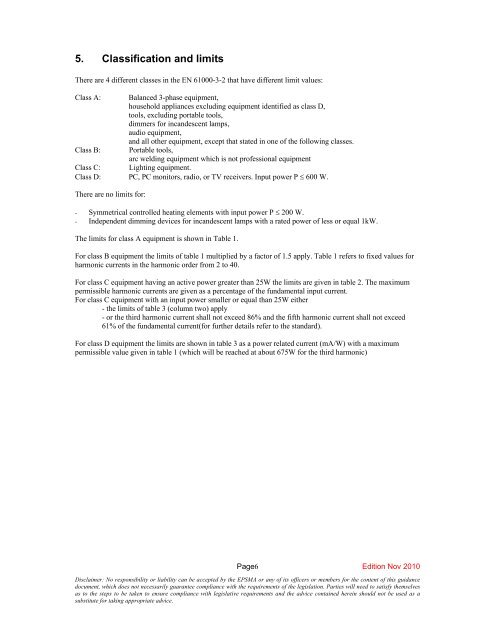Guidelines to the standard EN 61000-3-2 - European Power Supply ...
Guidelines to the standard EN 61000-3-2 - European Power Supply ...
Guidelines to the standard EN 61000-3-2 - European Power Supply ...
Create successful ePaper yourself
Turn your PDF publications into a flip-book with our unique Google optimized e-Paper software.
5. Classification and limits<br />
There are 4 different classes in <strong>the</strong> <strong>EN</strong> <strong>61000</strong>-3-2 that have different limit values:<br />
Class A: Balanced 3-phase equipment,<br />
household appliances excluding equipment identified as class D,<br />
<strong>to</strong>ols, excluding portable <strong>to</strong>ols,<br />
dimmers for incandescent lamps,<br />
audio equipment,<br />
and all o<strong>the</strong>r equipment, except that stated in one of <strong>the</strong> following classes.<br />
Class B: Portable <strong>to</strong>ols,<br />
arc welding equipment which is not professional equipment<br />
Class C: Lighting equipment.<br />
Class D: PC, PC moni<strong>to</strong>rs, radio, or TV receivers. Input power P 600 W.<br />
There are no limits for:<br />
- Symmetrical controlled heating elements with input power P 200 W.<br />
- Independent dimming devices for incandescent lamps with a rated power of less or equal 1kW.<br />
The limits for class A equipment is shown in Table 1.<br />
For class B equipment <strong>the</strong> limits of table 1 multiplied by a fac<strong>to</strong>r of 1.5 apply. Table 1 refers <strong>to</strong> fixed values for<br />
harmonic currents in <strong>the</strong> harmonic order from 2 <strong>to</strong> 40.<br />
For class C equipment having an active power greater than 25W <strong>the</strong> limits are given in table 2. The maximum<br />
permissible harmonic currents are given as a percentage of <strong>the</strong> fundamental input current.<br />
For class C equipment with an input power smaller or equal than 25W ei<strong>the</strong>r<br />
- <strong>the</strong> limits of table 3 (column two) apply<br />
- or <strong>the</strong> third harmonic current shall not exceed 86% and <strong>the</strong> fifth harmonic current shall not exceed<br />
61% of <strong>the</strong> fundamental current(for fur<strong>the</strong>r details refer <strong>to</strong> <strong>the</strong> <strong>standard</strong>).<br />
For class D equipment <strong>the</strong> limits are shown in table 3 as a power related current (mA/W) with a maximum<br />
permissible value given in table 1 (which will be reached at about 675W for <strong>the</strong> third harmonic)<br />
Page6 Edition Nov 2010<br />
Disclaimer: No responsibility or liability can be accepted by <strong>the</strong> EPSMA or any of its officers or members for <strong>the</strong> content of this guidance<br />
document, which does not necessarily guarantee compliance with <strong>the</strong> requirements of <strong>the</strong> legislation. Parties will need <strong>to</strong> satisfy <strong>the</strong>mselves<br />
as <strong>to</strong> <strong>the</strong> steps <strong>to</strong> be taken <strong>to</strong> ensure compliance with legislative requirements and <strong>the</strong> advice contained herein should not be used as a<br />
substitute for taking appropriate advice.


